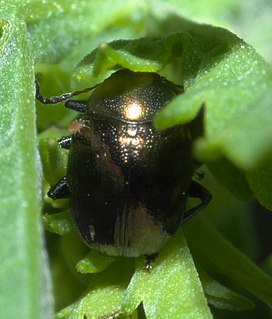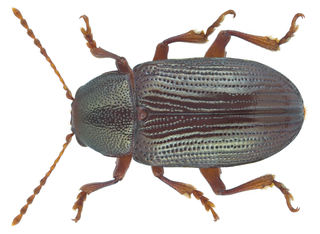
Colasposoma is a genus of leaf beetles in the subfamily Eumolpinae. It is known from Africa, Asia and Australia.
Afroeurydemus armatus is a species of leaf beetle of the Republic of the Congo and the Democratic Republic of the Congo, observed by J. Achard in 1915.
Afroeurydemus bimaculatus is a species of leaf beetle of Ivory Coast, Gabon, the Republic of the Congo and the Democratic Republic of the Congo, observed by Édouard Lefèvre in 1877.
Afroeurydemus puncticollis is a species of leaf beetle. It is distributed in the Democratic Republic of the Congo and Ethiopia. It was described by Bryant in 1933.
Gaberella is a genus of leaf beetles in the subfamily Eumolpinae, found in Africa. It contains only one species, Gaberella costata, found in Sudan, Uganda, the Republic of the Congo, the Democratic Republic of the Congo, Cameroon, Bioko and Ivory Coast. This species was first described by Joseph Sugar Baly in 1878, and was originally placed in Menius.

Paraivongius bicolor is a species of leaf beetle of the Democratic Republic of the Congo, described by Édouard Lefèvre in 1885.
Sarum inermis is a species of leaf beetle of the Democratic Republic of the Congo, observed by Jacoby in 1901.

Rhembastus is a genus of leaf beetles in the subfamily Eumolpinae, native to Africa. Whilst the taxonomy of the genus is disputed, the genus has been suggested as a biological control agent for Bryophyllum delagoense in Australia.

Eumolpini is a tribe of leaf beetles in the subfamily Eumolpinae. It is the largest tribe in the subfamily, with approximately 170 genera found worldwide. Members of the tribe almost always have a longitudinal median groove on the pygidium, which possibly helps to keep the elytra locked at rest. They also generally have a subglabrous body, as well as appendiculate pretarsal claws.

Typophorini is a tribe of leaf beetles in the subfamily Eumolpinae. The tribe contains approximately 100 genera, which are found worldwide. Members of the tribe are mainly characterized by notches on the tibiae of the middle and hind legs, which are sometimes referred to as antenna cleaners. They also generally have a subglabrous body, as well as bifid pretarsal claws.
Sarum is a genus of leaf beetles in the subfamily Eumolpinae, found in Africa. Most of its species were originally placed in Rhembastus.
Mandollia is a genus of leaf beetles in the subfamily Eumolpinae, found in Africa. Two of its species were originally placed in Rhembastus.
Chloropterus is a genus of leaf beetles in the subfamily Eumolpinae. It is distributed in Eastern Europe, West to Central Asia and North Africa.

Eurydemus is a genus of leaf beetles in the subfamily Eumolpinae. It is known from Africa and Fiji.
Melindea is a genus of leaf beetles in the subfamily Eumolpinae. It is known from Africa.

Zohrana is a genus of leaf beetles in the subfamily Eumolpinae. It is known from Africa. It is also sometimes known as Zohranus.
Semmiona is a genus of leaf beetles in the subfamily Eumolpinae. It is known from Africa.
Pheloticus is a genus of leaf beetles in the subfamily Eumolpinae. It is found in Madagascar.

Bromiini is a tribe of leaf beetles in the subfamily Eumolpinae. The tribe contains approximately 120 genera, which are found worldwide. They are generally thought to be an artificial group, often with a subcylindrical prothorax without lateral ridges and covered with setae or scales.







